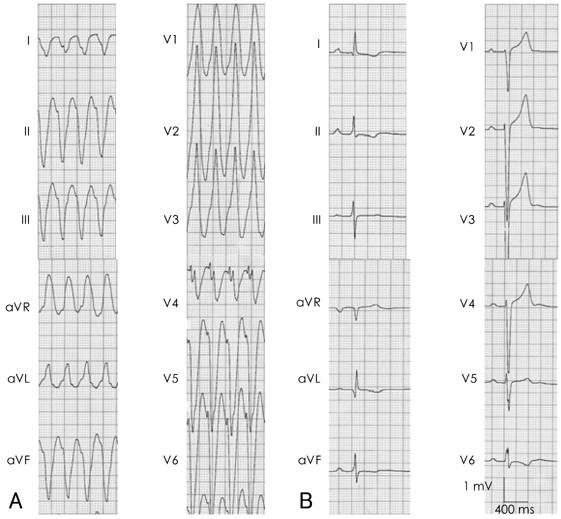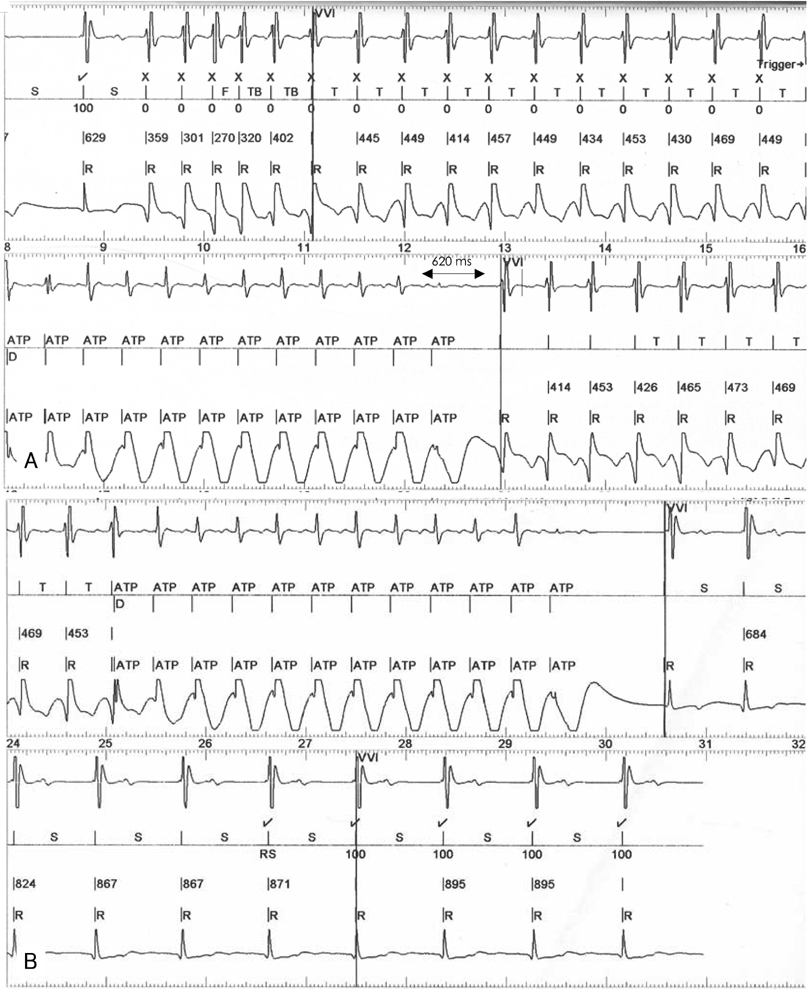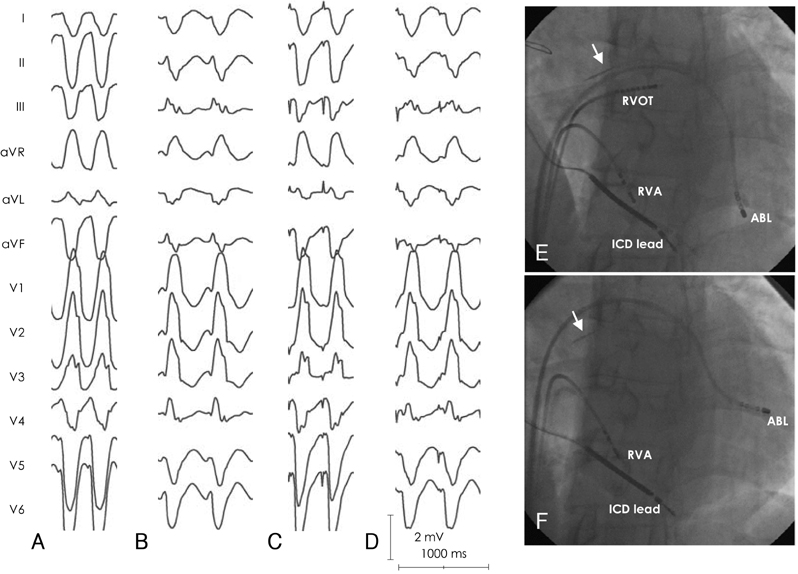Korean Circ J.
2008 Jan;38(1):60-65. 10.4070/kcj.2008.38.1.60.
Electrical Storm Late after Surgery for a Double-Chambered Right Ventricle, Aortic Regurgitation and a Ventricular Septal Defect: A Case of Successful Catheter Ablation
- Affiliations
-
- 1Department of Internal Medicine, Pusan National University School of Medicine, Busan, Korea. mdjunkim@yahoo.co.kr
- KMID: 2225875
- DOI: http://doi.org/10.4070/kcj.2008.38.1.60
Abstract
- An electrical storm is defined as multiple occurrences of ventricular tachycardia/fibrillation (VT/VF) within a single day; this is a medical emergency and a poor prognostic marker in patients with an implantable cardioverter-defibrillator (ICD). We report here on the occurrence of electrical storms in a 35-year-old man with a repaired DCRV and ICD. He had recurrent VT and electrical storms that were refractory to amiodarone and beta-blocker. A cardiac electrophysiologic study was performed 11 months after the ICD was implanted and two forms of VT were induced. After the catheter ablation of the VTs, the monomorphic VT became non-inducible. The frequency of the VT decreased from 35 per month before the catheter ablation to 1.1 times per month after the procedure. Catheter ablation of VT could be an effective treatment for patients with electrical storms refractory to antiarrhythmic drugs.
Keyword
MeSH Terms
Figure
Reference
-
1. Villacastin J, Almendral J, Arenal A, et al. Incidence and clinical significance of multiple consecutive, appropriate, high-energy discharges in patients with implanted cardioverter-defibrillators. Circulation. 1996. 93:753–762.2. Credner SC, Klingenheben T, Mauss O, Sticherling C, Hohnloser SH. Electrical storm in patients with transvenous implantable cardioverterdefibrillators: incidence, management and prognostic implications. J Am Coll Cardiol. 1998. 32:1909–1915.3. Exner DV, Pinski SL, Wyse DG, et al. Electrical storm presages nonsudden death. Circulation. 2001. 103:2066–2071.4. Nademanee K, Taylor R, Bailey WE, Rieders DE, Kosar EM. Treating electrical storm: sympathetic blockade versus advanced cardiac life support-guided therapy. Circulation. 2000. 102:742–747.5. Kurisu S, Inoue I, Kawagoe T, et al. Temporary overdriving pacing as an adjunct to antiarrhythmic drug therapy for electrical storm in acute myocardial infarction. Circ J. 2005. 69:613–616.6. Bansch D, Ouyang F, Antz M, et al. Successful catheter ablation of electrical storm after myocardial infarction. Circulation. 2003. 108:3011–3016.7. Li YG, Gronefeld G, Israel C, Hohnloser SH. Catheter ablation of frequently recurring ventricular fibrillation in a patient after aortic valve repair. J Cardiovasc Electrophysiol. 2004. 15:90–93.8. Choi KJ, Lee MY, Kim HS, et al. Radiofrequency catheter ablation of idiopathic left ventricular tachycardia. Korean Circ J. 1997. 27:20–29.9. Kim YH, Sosa-Suarez G, Trouton TG, et al. Treatment of ventricular tachycardia by transcatheter radiofrequency ablation in patients with ischemic heart disease. Circulation. 1994. 89:1094–1102.10. Stevenson WG, Friedman PL, Sweeney MO. Catheter ablation as an adjunct to ICD therapy. Circulation. 1997. 96:1378–1380.11. Alexander ME, Cecchin F, Walsh EP, Triedman JK, Bevilacqua LM, Berul CI. Implications of implantable cardioverter defibrillator therapy in congenital heart disease and pediatrics. J Cardiovasc Electrophysiol. 2004. 15:72–76.12. Cabrera A, Martinez P, Rumoroso R, et al. Double-chambered right ventricle. Eur Heart J. 1995. 16:682–686.13. Alvarez M, Tercedo L, Lazano JM, Azpitarte J. Sustained monomorphic ventricular tachycardia associated with unrepaired double-chambered right ventricle. Europace. 2006. 8:901–903.14. Caceres J, Jazayeri M, McKinnie J, et al. Sustained bundle branch reentry as a mechanism of clinical tachycardia. Circulation. 1989. 79:256–270.15. Narasimhan C, Jazayeri MR, Sra J, et al. Ventricular tachycardia in valvular heart disease: facilitation of sustained bundle branch reentry by valve surgery. Circulation. 1997. 96:4307–4313.16. Merino JL, Peinado R, Fernadez-Lozno I, et al. Buncle-branch reentry and the postpacing interval after entrainment by right ventricular apex stimulation: a new approach to elucidate the mechanism of wide-QRS-complex tachycardia with atrioventricular dissociation. Circulation. 2001. 103:1102–1108.17. Lewalter T, Jung W, Preusse CJ, et al. Radiofrequency catheter ablation of an incessant ventricular tachycardia following valve surgery. Pacing Clin Electrophysiol. 2002. 25:105–108.18. Eckart RE, Hruczkowski TW, Tedrow UB, Koplan BA, Epstein LM, Stevenson WG. Sustained ventricular tachycardia associated with corrective valve surgery. Circulation. 2007. 116:2005–2011.19. Josephson ME, Waxman HL, Gain ME, Gardner MJ, Buxton AE. Ventricular activation during ventricular endocardial pacing: II. role of pace-mapping to localize origin of ventricular tachycardia. Am J Cardiol. 1982. 50:11–22.20. Wilber DJ, Baerman J, Olshansky B, Kall J, Kopp D. Adenosine-sensitive ventricular tachycardia: clinical characteristics and response to catheter ablation. Circulation. 1993. 87:126–134.
- Full Text Links
- Actions
-
Cited
- CITED
-
- Close
- Share
- Similar articles
-
- A Case of Double Chambered Right Ventricle with Congenital Right Ventricular True Diverticulum
- Two Cases of Double-Chambered Right Ventricle without Other Congenital Cardiac Anomalies
- Noonan Syndrome with Double-Chambered Right Ventricle and Atrial Septal Defect: 1 Case Report
- Double Chambered Right Ventricle with Ventricular Septal Defect in Adults: Case Series and Review of the Literature
- Mid-Septal Hypertrophy and Apical Ballooning; Potential Mechanism of Ventricular Tachycardia Storm in Patients with Hypertrophic Cardiomyopathy





